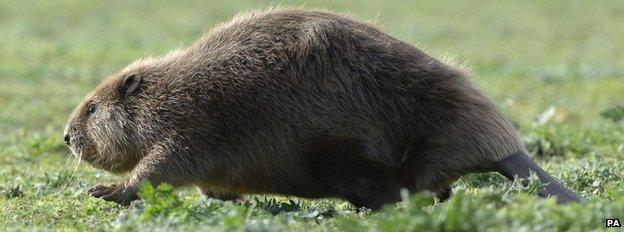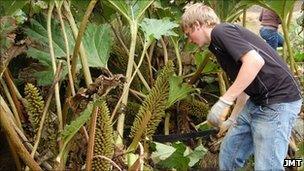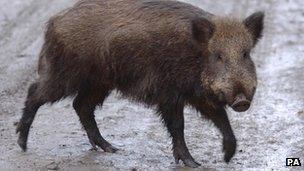Weird things: The Highlands' unusual animals and plants
- Published

A beaver has been among some of the unusual animals to have been found in the Highlands and Islands
A large Eurasian eagle owl has been causing a flap in Inverness. But it is not the only non-native species or unusual creature to have caused a stir in the Highlands and Islands.
Big cats
In 1980, a puma was captured at Cannich, Inverness-shire.
It was taken to the Highland Wildlife Park, at Kincraig. Nicknamed Felicity, it spent five years at the park.
After the cat died it was stuffed and is on display at Inverness Museum and Art Gallery.
Other big cats are said to be at large in the Highlands.

Are big cats roaming free in the Highlands?
Police probed reports of a big cat attacking and killing sheep in Sutherland in 2011.
In 2010, Northern Constabulary issued a warning to the public after reports of big cats in Sutherland and Easter Ross.
A "large panther-type" cat was spotted walking near Dornoch's caravan park and golf course.
Another member of the public spotted what they described as a "very large, muscular black cat with a square head" in the Fendon area of Tain.
Also in 2010, a "very large black cat" was seen by a member of the public in woodland at Inshriach, Kincraig.
A police spokesman said it was unusual to have big cat sightings so close together.
Invasive shellfish
North American signal crayfish were found in two ponds at Ballachulish Quarry in Lochaber last year.
The crayfish are considered to be a threat to native insects, frogs and small fish.
Highland Council, Scottish Natural Heritage and Scottish Environment Protection Agency put up £76,000 to pay for the Ballachulish population to be poisoned to prevent them from spreading to other areas.
Giant rhubarb
A non-native, invasive species of rhubarb called Gunnera tinctoria threatened wild plants in parts of Harris in the Western Isles after growing out of control.
Two years ago, the North Harris Trust and landscape charity the John Muir Trust (JMT) recruited volunteers to hack away plants with machetes.

Volunteers hacked away giant invasive rhubarb in an effort to prevent it from spreading
JMT said pockets of rhubarb "jungle" had grown on the outskirts of Tarbert.
North Harris Trust ranger Robin Reid, who co-ordinated the eradication project, said at the time: "Alongside climate change and habitat loss, non-native species like Gunnera are one of the biggest threats to biodiversity."
Within days, volunteers had collected a rubbish skip full of rhubarb pods, representing more than 100 million seeds, which were turned into compost.
Exotic sea life
A leatherback turtle was spotted in the sea off Scotland's west coast in 2011.
Crew members of the Hebridean Whale and Dolphin Trust research vessel Silurian estimated it was about 1.5m (5ft) long.
They saw the turtle in the Minch, a stretch of water between the Western Isles and mainland Scotland.

A green turtle was thought to have died from the cold off the Scottish coast
Leatherbacks nest in the tropics and are the world's biggest turtle and listed as critically endangered.
Dave Hanna, skipper of the Silurian, said seeing the turtle was the most exciting moment of his life.
In 2002, a rare green turtle was found dead off Loch Inver on the north west coast of Scotland.
At the time it was believed to be only the third recorded discovery of a green turtle in Scottish waters in more than 150 years.
The animal normally lives in tropical and sub-tropical waters and scientists said it probably perished in the cold after losing its way.
Beach beaver
A beaver found dead on a beach at Eathie in the Black Isle in 2008 suffered a "cruel" death after ingesting a large quantity of sea water, according to police.
Police suspected the animal was linked to illegal releases of beavers in other parts of Scotland.
Once native to Britain, beavers were hunted to extinction more than 400 years ago.
Free-roaming pigs
Wild boar and also free-roaming pigs believed to be a mix boar and domestic pig have been spotted in various parts of the Highlands.
After escaping from a farm, they were spotted in the Strathnairn area near Inverness last year.

Wild boar have been spotted at various locations in the Highlands
Local councillor Roddy Balfour said there were worries the animals would dig up potato crops.
In 2011, feral wild boar were spotted searching for food in the gardens of homes in Invermoriston, near Loch Ness.
Residents told of seeing the pigs on their properties and nearby roads.
And in 2002, police were involved in efforts to catch a wild boar roaming between Newtonmore and Laggan. It was later shot by a local landowner.
- Published31 January 2013